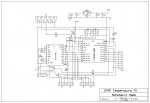I want to read data from a Holtec HT9170D DTMF receiver (datasheet at http://www.alldatasheet.com/datasheet-pdf/pdf/64510/HOLTEK/HT9170D.html) into a PICaxe 08M. The HT9170 delivers hexadecimal data in parallel over 4 wires.
Reading this data directly with the 08M would use all its inputs, which is unsatisfactory.
My question is would it be simplest (both in terms of program complexity and component count) to try to convert the parallel data to serial, or woul it be better to just use a bigger picAXE and read the data directly. At present I am leaning toward the latter, just getting a picAXE with more input pins, but if anyone has a more elegant solution I'd love to hear it!
Thanks
Nick
Reading this data directly with the 08M would use all its inputs, which is unsatisfactory.
My question is would it be simplest (both in terms of program complexity and component count) to try to convert the parallel data to serial, or woul it be better to just use a bigger picAXE and read the data directly. At present I am leaning toward the latter, just getting a picAXE with more input pins, but if anyone has a more elegant solution I'd love to hear it!
Thanks
Nick

